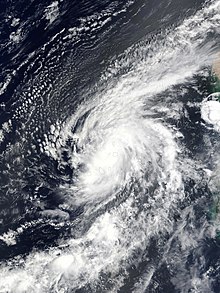 Fred over the Cape Verde Islands on August 31 | |
| Meteorological history | |
|---|---|
| Formed | August 30, 2015 |
| Dissipated | September 6, 2015 |
| Category 1 hurricane | |
| 1-minute sustained (SSHWS/NWS) | |
| Highest winds | 85 mph (140 km/h) |
| Lowest pressure | 986 mbar (hPa); 29.12 inHg |
| Overall effects | |
| Fatalities | 9 direct |
| Damage | $2.5 million (2015 USD) |
| Areas affected | West Africa, Cape Verde |
| IBTrACS | |
Part of the 2015 Atlantic hurricane season | |
Hurricane Fred was the easternmost Atlantic hurricane to form in the tropics, and the first to move through Cape Verde since 1892.[1] The second hurricane and sixth named storm of the 2015 Atlantic hurricane season, Fred originated from a well-defined tropical wave over West Africa in late August 2015. Once offshore, the wave moved northwestward within a favorable tropospheric environment and strengthened into a tropical storm on August 30. The following day, Fred grew to a Category 1 hurricane with peak winds of 85 mph (140 km/h) as it approached Cape Verde. After passing Boa Vista and moving away from Santo Antão, it entered a phase of steady weakening, dropping below hurricane status by September 1. Fred then turned to the west-northwest, enduring increasingly hostile wind shear, but maintained its status as a tropical cyclone despite repeated forecasts of rapid dissipation. It fluctuated between minimal tropical storm and tropical depression strength through September 4–5 before curving sharply to the north. By September 6, Fred's circulation pattern had diminished considerably, and the storm dissipated later that day.
Under threat from the hurricane, all of Cape Verde was placed under a hurricane warning for the first time in the nation's history. Gale-force winds battered much of the Barlavento region throughout August 31, downing trees and utility poles. On the easternmost islands of Boa Vista and Sal, Fred leveled roofs and left villages without power or phone services for a few days. About 70 percent of the houses in Povoação Velha suffered light to moderate damage. Across the northernmost islands, rainstorms flooded homes, washed out roads, and ruined farmland; São Nicolau endured great losses of crops and livestock. Material damage across Cape Verde totaled US$2.5 million,[nb 1] though the rain's overall impact on agriculture was positive and replenishing. Swells from the hurricane produced violent seas along the West African shoreline, destroying fishing villages and submerging swaths of residential areas in Senegal. Between the coasts of West Africa and Cape Verde, maritime incidents related to Fred resulted in nine deaths.
- ^ Cite error: The named reference
TCRwas invoked but never defined (see the help page). - ^ "XE Currency Charts: USD to CVE". XE. 2015. Retrieved 2017-10-01.
Cite error: There are <ref group=nb> tags on this page, but the references will not show without a {{reflist|group=nb}} template (see the help page).